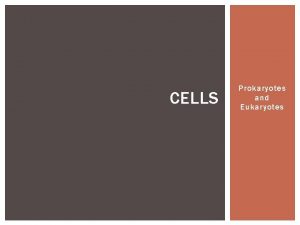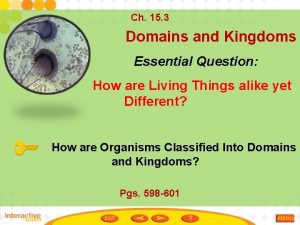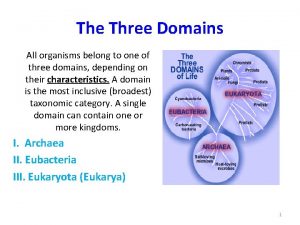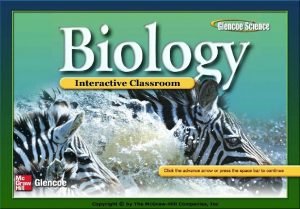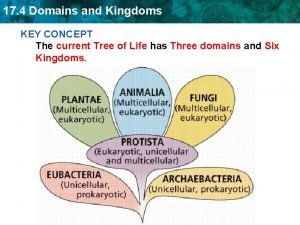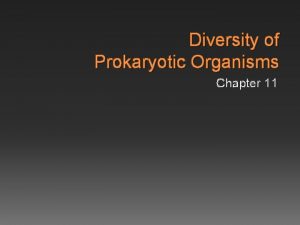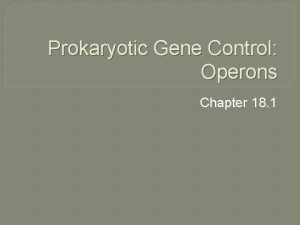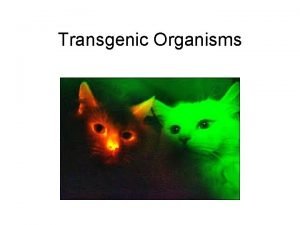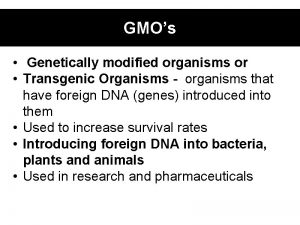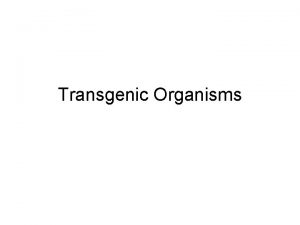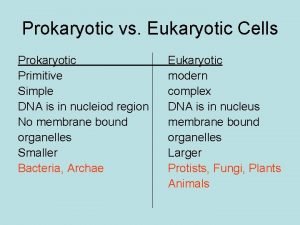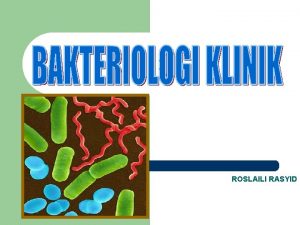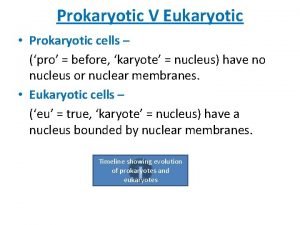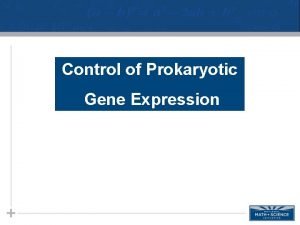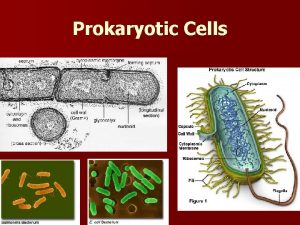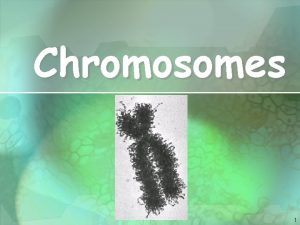The Diversity of Prokaryotic Organisms Chapter 11 Domains





































- Slides: 37

The Diversity of Prokaryotic Organisms Chapter 11

Domains Bacteria and Archaea • One circular chromosome –not in a membrane • 70 S ribosomes • No membrane-bound organelles • Binary fission –r. RNA provides evidence of phylogenic differences between the 2 Domains

Domain Bacteria • Proteobacteria – Includes most of the gram-negative bacteria – Phylogeny based on r. RNA studies – Common photosynthetic ancestor • few are still photosynthetic – Mythical Greek god, Proteus – Largest taxonomic group of bacteria – Classes designated by Greek letters

The (alpha) Proteobacteria • Some grow at low nutrient levels • Some have unusual morphology • Many are agriculturally important • several medically important genra

The (alpha) Proteobacteria • Human pathogens: – Bartonella - bacillus • Cat-scratch disease

• Obligate intracellular parasite: – Rickettsia – bacillus or coccobacilli • Arthropod-borne cause spotted fevers • R. typhi - Endemic murine typhus (fleas) • R. rickettsii - Rocky Mountain Spotted Fever (ticks)

• Have prosthecae: – Caulobacter • Stalked bacteria found in low nutrient aquatic environment • – Hyphomicrobium • Budding bacteria found in low nutrient environment

• Pelagibacter – Very small with tiny genome – P. ubique is abundant marine microbe

• Nitrogen-fixing bacteria: – Azospirillum • Grows in association with tropical grasses and sugar cane – Rhizobia • Rhizobium, Bradyrhizobium • Infects roots of legumes forming root nodules

• Nitrifying bacteria : – Chemoautotrophs – Oxidize nitrogen • Nitrosomonas NH 4+ NO 2– (ammonium to nitrite) • Nitrobacter NO 2– NO 3– (nitrite to nitrate)

• Plant pathogen: – Agrobacterium • Inserts plasmid into plant cells, inducing tumors • Crown gall

• Produce acetic acid from ethyl alcohol: – Acetobacter – Gluconobacter

• Wolbachia – Most common infectious bacteria – Endosymbionts of insects and other animals

The (beta) Proteobacteria • Utilize nutrients diffusing from areas of decomposition of organic matter • hydrogen gas, ammonia, and methane

• Thiobacillus – Chemoautotroph, oxidizes sulfur: H 2 S SO 42– • Sphaerotilus - hollow sheath - polar flagella - problem in sewage

• Spirillum – Large, aerobic freshwater bacterium

• Neisseria – N. meningitidis • Meningococcal meningitis – N. gonorrhoeae

• Bordetella – Aerobic, rods or coccobacillus – B. pertussis - whooping cough

The (gamma) Proteobacteria • Largest subgroup • Great variety of physiological types • Includes the enterics

• Beggiatoa – Chemoautotroph, oxidize H 2 S to S 0 – Gliding motility – Beggiatoa alba is only species • Azotobacter and Azomonas – Nitrogen fixing, free-living soil bacteria – Large ovoid cell with heavy capsule

• Francisella – Pleomorphic – Francisella tularensis – tularemia (rabbit fever) • Resistant to many antibiotics

• Pseudomonas – – – Aerobic rods; Polar flagella Extra-cellular and/or florescent pigments Opportunistic pathogen Metabolize wide variety of substrates Resistant to many anti-microbials Denitrification

• Legionella – Found in streams, warm-water pipes, cooling towers – L. pneumophilia • Causes a form of pneumonia called legionellosis • Survive inside aquatic amoeba

• Coxiella – Coxiella burnetii • Q fever • Obligate intracellular pathogen • transmitted via aerosols or milk • Resistant spore–like body

• Vibrio – Facultative anaerobic vibrio – Vibrio cholerae • Cholera • Dysentery – V. parahaemolyticus • Less severe gastroenteritis • Undercooked shellfish

• Pasteurella – – mainly pathogens of domestic animals Cause pneumonia and septicemia passed to humans from cat and dog bites P. multocidia - carried by Komodo dragon

• Haemophilus – inhabit mucous membranes of upper respiratory tract, mouth, vagina, and intestinal tract – require heme fraction (X factor) and NAD cofactor (V factor) – H. ducreyi • Chancroid (STD) – H. influenzae • meningitis, pneumonia, bronchitis, septic arthritis, earaches

• Enterobacteriales (enterics): • • Facultatively anaerobic, rods Peritrichous flagella Most ferment glucose and other sugars Inhabit intestinal tract of animals (humans)

Enterics • Escherichia – Coliforms – fecal contamination – UTI and Travelers Diarrhea – Food poisoning – E. coli 0157: H 7 • Salmonella – S. enterica – 2400 servors – S. enterica servor typhi – typhoid fever

Enterics • Shigella – Shigellosis (bacillary dysentery) • Klebsiella – K. pneumoniae – serious form of pneumonia – Some species fix nitrogen

Enterics • Yersinia – Y. pestis – plague • Proteus – Swarmer cells – UTI and wound infections

The (delta) Proteobacteria • Some species are predators on other bacteria • Important contributors to the sulfur cycle

• Bdellovibrio – Aerobic, rod with polar flagella – attack other gram (-) bacteria similar to the way a virus would

• Desulfovibrio – Human intestinal tract and anaerobic sediments – obligate anaerobe, sulfur reducing bacteria – Use S for final electron acceptor – Release tons of H 2 S annually

• Myxococcus – Gliding motility – Feed on bacteria they encounter – Cells aggregate to form fruiting body loaded with myxospores

The (epsilon) Proteobacteria • Microaerophilic, helical or vibrioid rods • Motile by means of flagella

– Campylobacter • C. fetus – causes spontaneous abortion in domestic animals • C. jejuni – leading cause of bacterial diarrhea – Helicobacter • H. pylori – common cause of stomach ulcers
 Domains of prokaryotic cells
Domains of prokaryotic cells How are organisms classified into domains and kingdoms
How are organisms classified into domains and kingdoms The organism quercus phellos is a member of the species
The organism quercus phellos is a member of the species What are the 3 domains?
What are the 3 domains? Organizing lifes diversity
Organizing lifes diversity Member of the same species
Member of the same species Unicellular multicellular organisms
Unicellular multicellular organisms Why is genetic diversity important
Why is genetic diversity important Genetic diversity vs species diversity
Genetic diversity vs species diversity Chapter 17 domains and kingdoms answer key
Chapter 17 domains and kingdoms answer key Concept mapping domains and kingdoms
Concept mapping domains and kingdoms Hát kết hợp bộ gõ cơ thể
Hát kết hợp bộ gõ cơ thể Slidetodoc
Slidetodoc Bổ thể
Bổ thể Tỉ lệ cơ thể trẻ em
Tỉ lệ cơ thể trẻ em Chó sói
Chó sói Chụp tư thế worms-breton
Chụp tư thế worms-breton Chúa sống lại
Chúa sống lại Môn thể thao bắt đầu bằng từ chạy
Môn thể thao bắt đầu bằng từ chạy Thế nào là hệ số cao nhất
Thế nào là hệ số cao nhất Các châu lục và đại dương trên thế giới
Các châu lục và đại dương trên thế giới Công thức tiính động năng
Công thức tiính động năng Trời xanh đây là của chúng ta thể thơ
Trời xanh đây là của chúng ta thể thơ Mật thư tọa độ 5x5
Mật thư tọa độ 5x5 Làm thế nào để 102-1=99
Làm thế nào để 102-1=99 Phản ứng thế ankan
Phản ứng thế ankan Các châu lục và đại dương trên thế giới
Các châu lục và đại dương trên thế giới Thơ thất ngôn tứ tuyệt đường luật
Thơ thất ngôn tứ tuyệt đường luật Quá trình desamine hóa có thể tạo ra
Quá trình desamine hóa có thể tạo ra Một số thể thơ truyền thống
Một số thể thơ truyền thống Cái miệng xinh xinh thế chỉ nói điều hay thôi
Cái miệng xinh xinh thế chỉ nói điều hay thôi Vẽ hình chiếu vuông góc của vật thể sau
Vẽ hình chiếu vuông góc của vật thể sau Nguyên nhân của sự mỏi cơ sinh 8
Nguyên nhân của sự mỏi cơ sinh 8 đặc điểm cơ thể của người tối cổ
đặc điểm cơ thể của người tối cổ V. c c
V. c c Vẽ hình chiếu đứng bằng cạnh của vật thể
Vẽ hình chiếu đứng bằng cạnh của vật thể Vẽ hình chiếu vuông góc của vật thể sau
Vẽ hình chiếu vuông góc của vật thể sau Thẻ vin
Thẻ vin
